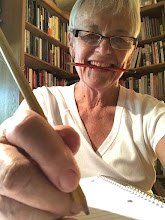In addition to learning about the local history, we also are learning a lot about natural history, science, and geography, all of which introduces new vocabulary. For instance, the concept of erosion has come up on each of our field trips, and we've learned about things like water sheds and various meanings of the word Gothic (more on that later). Sometimes the new vocabulary exceeds the readiness of kindergartener Candice and second 
We enjoyed the trek down the steep trail, that Cody calculated was .75 miles after reading the map I brought and learning that the round trip was one and half miles (practical math skills). But what goes down must come up, so the return trip which climbs 300 feet had Jenny and I behind the kids who raced onward. However, we all stopped to read the monument part way up the path which describes how Emmanuel Airola owned the land where he grazed cattle before his family gave the land to the New Melones Reservoir Project.
On our way back to Columbia, I read a short article written in 1862 which describes the caves as Gothic in appearance. We discussed the word Gothic which Taylor knew to mean someone who dressed in dark clothes and had died black hair. From there we stepped back in history to relate the word to the "dark" ages and a time of "dark" castles made of stone that looked a lot like the "dark" cave we had just visited.
We stopped at a monument by the Parrott's Ferry Bridge before driving out of the canyon. The crumbling monument was built in 1949 (a year after I was born--another calculation for the kids). Taylor read aloud the inscription about the ferry that was run by a man named Parrott to take people back and forth across the river before the first bridge was built. We looked at the high water marks on the canyon walls and the bridge and watched the swallows building mud nests under the bridge. Jenny pointed out the sag in the middle of the bridge. She said she read a story in the Union Democrat a number of years ago about the bridge sagging shortly after it was built.
When we got back to Columbia, we ate our lunch at a picnic table and then bought ice cream cones at the Fallon house. While we were sitting on a bench licking ice cream, Kyle shouted, "Look there's a document!" We all looked to where he was pointing across the street. "No," he said. "I mean a monument." Sure enough a stone monument like the ones we'd been visiting stood directly across from where we sat. Jenny and I grinned at each other: Vocabulary acquisition in progress. Field trips are great vehicles for learning.






No comments:
Post a Comment